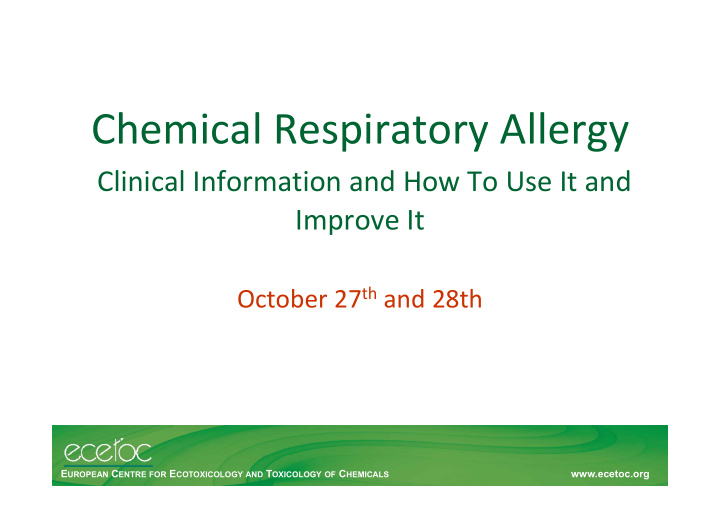



Chemical Respiratory Allergy Clinical Information and How To Use It and Improve It October 27 th and 28th E UROPEAN C ENTRE FOR E COTOXICOLOGY AND T OXICOLOGY OF C HEMICALS www.ecetoc.org
Introduction, Aims and Objectives, Plan for the 2 days Stella Cochrane E UROPEAN C ENTRE FOR E COTOXICOLOGY AND T OXICOLOGY OF C HEMICALS www.ecetoc.org
Introduction Human thresholds of chemical respiratory sensitisation and elicitation are poorly characterised. This coupled with uncertainty regarding mechanisms, exposure routes and a lack of validated hazard identification and characterisation approaches means there is great uncertainty regarding the identification and safe-use of R42 classified substances Better guidance on how to use existing human data for the evaluation of respiratory sensitisers in weight of evidence assessments is needed More robust human threshold data would help refine the current risk assessment approaches for the use of such materials, both occupational and consumer E UROPEAN C ENTRE FOR E COTOXICOLOGY AND T OXICOLOGY OF C HEMICALS www.ecetoc.org
Aims and Objectives Develop best practice guidance on how to assess and use available human data for the identification and regulation of respiratory sensitizers, including the creation of a framework for the interpretation of strength of evidence and weighting. Explore opportunities to identify biomarkers for sensitisation to chemical respiratory allergens – and the use of such biomarkers for prospective monitoring of workforces to more accurately identify threshold data Chemical respiratory allergy: an immune-mediated hypersensitivity reaction to an exogenous LMW chemical resulting in symptoms such as asthma and rhinitis E UROPEAN C ENTRE FOR E COTOXICOLOGY AND T OXICOLOGY OF C HEMICALS www.ecetoc.org
Plan for the 2 Days Day 1 Series of Talks Panel Discussion and Q&A Break in to 2 groups – What the criteria for data admissibility and weighting for classification – The identification of biomarkers for chemical respiratory allergens and for sensitisation of respiratory tract Reporting back and conclusions Cocktail Dinner E UROPEAN C ENTRE FOR E COTOXICOLOGY AND T OXICOLOGY OF C HEMICALS www.ecetoc.org
Round Tables Groups Round Table 1/Green Group Round Table 2/Blue Group Danielle Botelho (R 1) Stella Cochrane (R 2) Josje Arts Frank Gerberick David Basketter (Chair 1) Dick Heederik Paul Cullinan Ian Kimber (Chair 2) Colin Ehnes Carlos Rodriguez Andreas Flueckiger Madhuri Singal Helmut Greim Alan Poole Madeleine Laffont Axel Schnuch E UROPEAN C ENTRE FOR E COTOXICOLOGY AND T OXICOLOGY OF C HEMICALS www.ecetoc.org
Plan for the 2 Days Day 2 All – Assessment of sensitising potential - relevance for classification and SVHC Reporting back Drafting of Outputs – Define and promote a consistent, best practice, strategy for the evaluation of available human data for respiratory sensitizers, for use by regulators in formal decision-making processes – Publish a consensus opinion on the research required for the identification of human biomarkers of chemical respiratory sensitisation, and application in prospective monitoring of workforces with the ultimate aim of refining current human threshold data to reduce uncertainty in current risk assessment approaches E UROPEAN C ENTRE FOR E COTOXICOLOGY AND T OXICOLOGY OF C HEMICALS www.ecetoc.org
Thank you E UROPEAN C ENTRE FOR E COTOXICOLOGY AND T OXICOLOGY OF C HEMICALS www.ecetoc.org
Recommend
More recommend